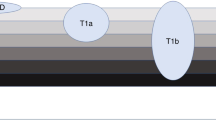Abstract
Photodynamic therapy (PDT) for cancer in the oesophagus and bronchi with red (630 nm) light may occasionally lead to wall perforation and fistula. Therefore, we investigated the clinical use of a less penetrating wavelength (514 nm) for the curative treatment of nine superficial carcinomas in the oesophagus and bronchi after photosensitization with Photofrin II. Tumours without infiltration beyond the submucosa in the oesophagus and beyond the lamina propria in the bronchi were considered as superficial cancers. The outcome and complications were compared with those of 13 superficial cancers treated with PDT and 630 nm light. In addition, we evaluated histologically the extent of the long-term tissue damage and scarring following treatment of six oesophageal cancers with either green or red light. At first endoscopic control, 7-10 days after PDT, tissue necrosis simply matched the illuminated area, without evidence of selective tumour damage. Six of nine tumours treated with 514 nm light had a complete response compared with nine of 13 after 630 nm irradiation. No perforation or fistula occurred in either treatment group. However, severe chest pain and fever with or without pleural effusion, consistent with occult perforation, were observed in three patients after 630 nm illumination in the oesophagus. Histologically, fibrous scarring in the three distinct sites treated with green light was limited to the superficial layers of the oesophagus. After red light treatment, transmural fibrosis with marked thinning of the oesophageal wall was evident in two of the three specimens available for inspection. These results indicate that PDT with 514 nm light has the potential to cure superficial cancer in the oesophagus and bronchi with essentially the same probability of success as red light. In the oesophagus, green light prevents deep tissue damage, thus reducing the risk of perforation.
This is a preview of subscription content, access via your institution
Access options
Subscribe to this journal
Receive 24 print issues and online access
$259.00 per year
only $10.79 per issue
Buy this article
- Purchase on Springer Link
- Instant access to full article PDF
Prices may be subject to local taxes which are calculated during checkout
Similar content being viewed by others
Author information
Authors and Affiliations
Rights and permissions
About this article
Cite this article
Grosjean, P., Wagnieres, G., Fontolliet, C. et al. Clinical photodynamic therapy for superficial cancer in the oesophagus and the bronchi: 514 nm compared with 630 nm light irradiation after sensitization with Photofrin II. Br J Cancer 77, 1989–1995 (1998). https://doi.org/10.1038/bjc.1998.330
Issue Date:
DOI: https://doi.org/10.1038/bjc.1998.330
This article is cited by
-
Metronomic photodynamic therapy using an implantable LED device and orally administered 5-aminolevulinic acid
Scientific Reports (2020)
-
Harnessing photochemical internalization with dual degradable nanoparticles for combinatorial photo–chemotherapy
Nature Communications (2014)
-
Photodynamic therapy for esophageal carcinoma*
European Surgery (2011)
-
Vascular regrowth following photodynamic therapy in the chicken embryo chorioallantoic membrane
Angiogenesis (2010)



